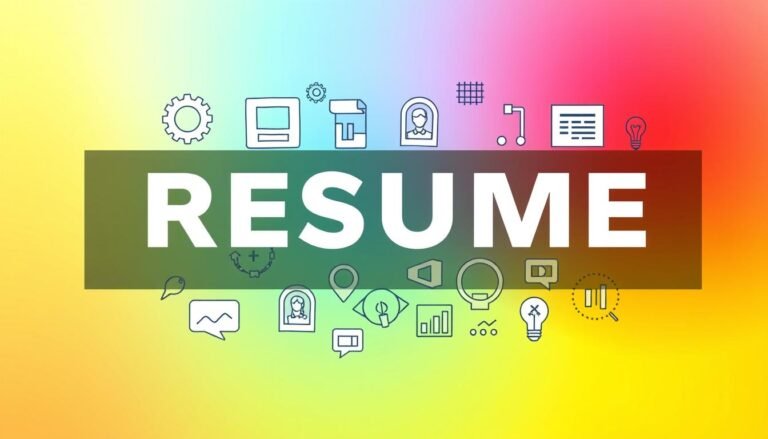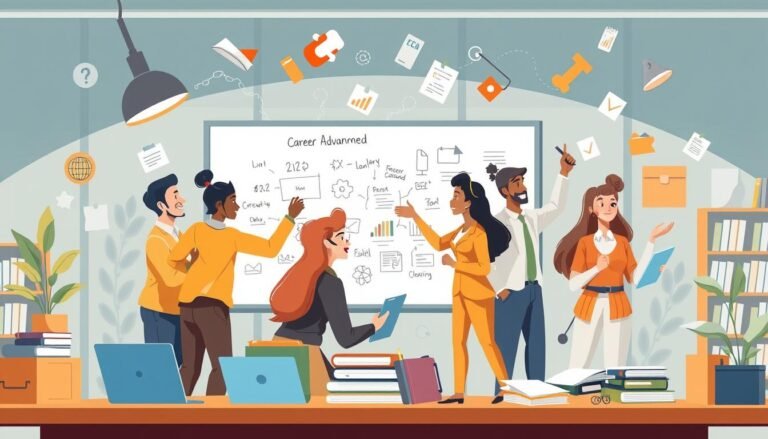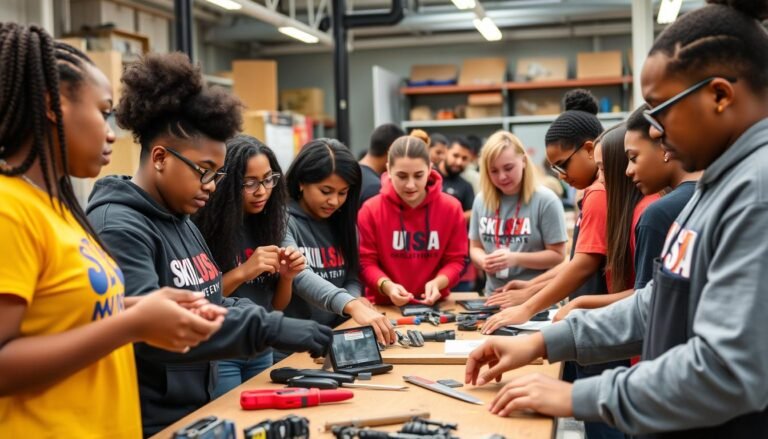National Skills Fund: Empowering America’s Workforce
Imagine if one initiative could change the American job market. It could bridge the skills gap and boost economic growth. The National Skills Fund is doing just that, changing how we develop our workforce.
Since January 2021, the Biden-Harris Administration has invested over $1.6 billion in workforce development. This move aims to revitalize U.S. supply chains and bring semiconductor manufacturing back home. It also aims to connect every American to high-speed internet.
The National Skills Fund is addressing the skills gap directly. Nearly 130 organizations are backing it, showing strong support. Business Leaders United is pushing for investments to prepare workers for new jobs. A coalition led by National Skills Coalition is asking for at least $100 billion in funding.
Earn-and-learn models like Registered Apprenticeships are key to this strategy. The administration has put over $440 million into these programs. They’re working with various groups to create a diverse and skilled workforce.
The results are clear. Secretary Gina Raimondo says the current administration has created 16 million jobs. With construction jobs at near-record levels, programs like the Million Women in Construction aim to increase female participation in construction by the next decade.
Key Takeaways
- Over $1.6 billion invested in workforce development since 2021
- Focus on revitalizing U.S. supply chains and manufacturing
- Expansion of Registered Apprenticeship programs
- Creation of 16 million jobs reported by Secretary Raimondo
- Initiatives to increase diversity in high-demand sectors
- Push for $100 billion in workforce development funding
- Emphasis on addressing the skills gap in America’s labor market
Understanding the National Skills Fund Initiative
The National Skills Fund (NSF) is a key program for improving skills in America’s workforce. It helps bridge the skills gap and boost career growth in many fields.
Goals and Objectives
The NSF helps adults over 19 get their first full Level 3 qualification. It offers free courses in areas like childcare, healthcare, engineering, and business management. This focus on investing in people creates jobs that don’t need a college degree.
Key Stakeholders
This initiative has a wide range of partners:
- Local officials
- Employers
- Unions
- Community colleges
- High schools
Historical Context and Development
The National Skills Coalition has been active since 2000, influencing many state and federal skills policies. The NSF’s impact has grown a lot over the years. From 2009 to 2013, spending jumped from $559 million to $2.664 billion, showing a strong commitment to helping workers.
| Year | NSF Expenditure | Annual Growth Rate |
|---|---|---|
| 2009/10 | $559 million | – |
| 2012/13 | $2.664 billion | Over 75% |
This big increase in funding shows how important the NSF is in helping people advance in their careers and driving economic growth with its reskilling programs.
Addressing the Skills Gap in America’s Labor Market
The U.S. labor market is facing a big skills gap. This gap affects economic growth and how we develop our workforce. By August 2020, the country was short 11.5 million jobs from February levels. This shows we need a strong talent pipeline.
Even with efforts to close this gap, we’re still facing hurdles. The Workforce Innovation and Opportunity Act (WIOA) adult program showed that most people leaving the program in early 2019 made about $23,333 a year. This highlights the need for better skill development programs.
The tech industry lacks diversity. Although 20% of computer science graduates are Black, Latino, or Hispanic, they only make up 10% of the tech workforce. This gap shows we need more diverse workforce development strategies.
The National Skills Fund is tackling these issues by focusing on in-demand fields. It helps workers gain new skills. For example, teacher externships prepare educators for fields like quantum computing and aerospace.
This fund is also adapting to changes brought on by artificial intelligence, automation, and globalization. It works with schools and industry leaders to create a skilled workforce. This will help drive economic growth.
“Investing equally in ‘lost Einsteins’ could quadruple the rate of innovation in the U.S.”
This strategy not only helps with the skills gap but also makes the job market more inclusive and prosperous. By using diverse talent, like older workers, people with disabilities, and veterans, companies can increase productivity and innovation. This leads to a more fair job market.
Workforce Development Strategies and Implementation
The National Skills Fund uses different strategies to improve America’s workforce. These strategies focus on job training, upskilling, and reskilling. They help people move forward in their careers. Let’s look at some key initiatives.
Apprenticeship Programs and Earn-and-Learn Models
Apprenticeships give you real-world experience while you earn money. They fill the gap between school and work, offering valuable training. For example, the Department of Labor supports Registered Apprenticeships as a successful way to learn and work.
Partnerships with Educational Institutions
Working together between industry and schools is key for workforce growth. Schools help students get ready for the job world. The Economic Development Administration put $500 million into training and placing 50,000 workers in good jobs across 31 states and 1 territory.
Industry-Specific Training Initiatives
Training programs are made for specific industries. For instance, the CHIPS for America Program gave $190 million for training in the semiconductor industry. This money will help support over 108,700 jobs in construction and manufacturing in nine states.
| Initiative | Investment | Impact |
|---|---|---|
| Good Jobs Challenge | $500 million | 50,000 workers trained and placed |
| CHIPS for America Program | $190 million | 108,700+ jobs supported |
| Tech Hubs Program | Up to $10 billion | 31 designated Tech Hubs |
These strategies aim to build a skilled workforce for a changing job market. By focusing on reskilling and upskilling, the National Skills Fund is helping people advance in their careers. This leads to economic growth.
Impact on Job Creation and Economic Growth
The National Skills Fund has greatly boosted economic growth and job creation in the U.S. It focuses on building a strong talent pipeline. This has been key in shaping the workforce.
Recent data shows the big impact of investing in people through the National Skills Fund:
- The U.S. unemployment rate is 3.8% as of August 2023
- 92% of jobs now need digital skills
- Workers with digital skills make 23% more
The program’s success is clear in its role in economic growth. It has helped fill the skills gap, creating millions of jobs and raising wages. The focus on digital skills has made a big difference:
| Digital Skill Level | Potential Earnings Increase |
|---|---|
| At least one digital skill | 23% higher |
| Three or more digital skills | 45% higher on average |
This rise in earnings means more tax money, with estimates of $1,363 to $2,879 per household each year. The National Skills Fund’s investment in people is a strong driver of economic growth and building a talent pipeline.
Targeting Underserved Communities and Promoting Inclusivity
The National Skills Fund is working hard to help underserved groups. It aims to close the skills gap and help everyone advance in their careers.
Initiatives for Women in the Workforce
Women are getting more opportunities in fields mostly filled by men. The Million Women in Construction aims to increase women in construction by 50% in ten years. This effort is part of a bigger plan to give more job chances to everyone.
Programs for Veterans and People of Color
Veterans and people of color are also getting extra support. Unemployment rates for Black and Latino workers have hit historic lows. The government is also spending more with small, disadvantaged businesses. These actions are making the job market more fair for everyone.
Addressing Barriers to Employment
The National Skills Fund is working to remove barriers to employment. They’re making childcare more affordable and helping people with disabilities find jobs. For instance, federal contractors can’t pay people with disabilities less than minimum wage now. These changes are helping many who were left out before.
Source Links
- People Powered Infrastructure – National Skills Coalition
- Celebrating and Unleashing America’s Workforce
- The National Skills Fund || The Sheffield College
- National Skills Coalition
- The labor market doesn’t have a ‘skills gap’—it has an opportunity gap
- How to Bridge the Skills Gap with Smart Hiring and Training
- Workforce Development | U.S. Economic Development Administration
- Investing in America, Investing in Americans Workforce Development Programs at the U.S. Department of Commerce
- Workforce Development and Training
- Employability, the Labor Force, and the Economy
- New Report: 92% of Jobs Require Digital Skills, One-Third of Workers Have Low or No Digital Skills Due to Historic Underinvestment, Structural Inequities – National Skills Coalition
- Federal investments in sector-based training can boost workers’ upward mobility
- Executive Order on Further Advancing Racial Equity and Support for Underserved Communities Through The Federal Government | The White House
- Fact Sheet: Investing in America’s Communities – The Economic Development Administration’s American Rescue Plan Programs | U.S. Economic Development Administration
- FACT SHEET: U.S. Department of Education Releases 2023 Update to Equity Action Plan, Outlines New Commitments to Advance Equity







